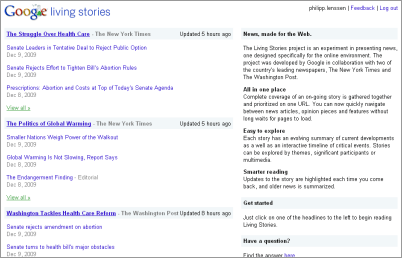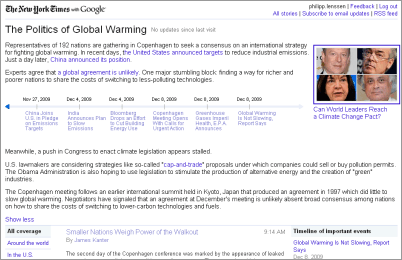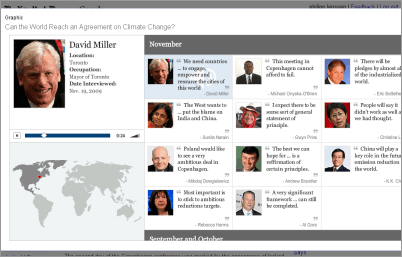Wednesday, December 9, 2009
Google’s "Living Stories" News Experiment
Google has partnered with the New York Times and the Washington Post news organizations to create an experimental type of news page they call “living story”. In a blog post announcing this move, Google says that Living Stories try a non-traditional approach of presenting news: “They unify coverage on a single, dynamic page with a consistent URL. They organize information by developments in the story. They call your attention to changes in the story since you last viewed it so you can easily find the new material. Through a succinct summary of the whole story and regular updates, they offer a different online approach to balancing the overview with depth and context.”
What does the article aggregation page feature? One page, for instance, is titled “The Politics of Global Warming”. On it we can find interacting elements such as evolving textual summaries, timelines, audio content, image and video content. Areas can be expanded, while other areas scroll with you. You can sort in a variety of ways, like to restrict the news to quotes, or US news, or by showing the oldest news first. There are widgets like maps showing a person’s location while streaming their audio quote. User comments are available too. Clicking on “Opinion” will list editorials only. Additionally, you can subscribe to email updates for a particular story set.
That’s a lot of variety and room for interaction, though I can’t yet tell if I wouldn’t actually prefer a mostly-text-only overview of the same thing, presenting overviews, quotes, insights, images etc. in the order the journalist (or the editors of Wikipedia collectively presenting a topic) would deem most reasonable... to decide on that I’d have to give this a longer try. Are these many choices empowering, or confusing?
In regards to partnerships, which always creates interesting fields for conflicts of interests, the New York Times is probably the one news organization that Google grants closest insight access for reporting. For instance, Google once allowed a NYT reporter to spend a day with the search quality team, “observing some internal meetings and talking to several top engineers.” The NYT has also employed search engine optimization techniques in the past which were often found to be borderline, even though we didn’t see Google punish them for it (I won’t conclude anything the NYT did was blackhat, because we often don’t know what exactly the Googlebot saw at which point in time; we may want to assume innocent until proven guilty, but we also need to realize that the one most likely to have proof in these and future cases will always be Google Inc). Instead, Google has started to offer more official ways for news organizations to get their content indexed in Google while hiding it to a portion of users through a “First Click Free” policy. This is not to state that Google is already playing favors or will do so in the future, but when Google calls a particular source a “world-class” news organization in a blog post and partners with them in their tools, we at least have reason to take a closer look.
Now, in old Google News, the bias created by any particular news organization is somewhat balanced by presenting a huge variety of news organizations. Google’s new experiment does not have this great source variety. Thus, the bias from the content producer is carried on by the tool maker. Here is a sample of NYT bias alleged by editors of Wikipedia – whether or not you agree with this particular bit, it goes to show that there’s at least grounds for discussion when Google decides to go with a limited set of sources only:
In the build up to the 2003 war the New York Times published a number of stories claiming to prove that Iraq possessed WMD. One story in particular, written by Judith Miller helped persuade the American public that Iraq had WMD: in September 2002 she wrote about an intercepted shipment of aluminum tubes which the NYT said were to be used to develop nuclear material. It is now clear that they could not be used for that purpose. The story was followed up with television appearances by Colin Powell, Donald Rumsfeld and Condoleezza Rice all pointing to the story as part of the basis for taking military action against Iraq. Miller’s sources were introduced to her by Ahmed Chalabi, an Iraqi exile favorable to a U.S. invasion of Iraq. Miller is also listed as a speaker for The Middle East Forum, an organization which openly declared support for an invasion.
From another angle, propaganda and power structures critic Noam Chomsky in an interview once stated:
[T]he elite media are sort of the agenda-setting media. That means The New York Times, The Washington Post, the major television channels, and so on. They set the general framework. Local media more or less adapt to their structure.
And they do this in all sorts of ways: by selection of topics, by distribution of concerns, by emphasis and framing of issues, by filtering of information, by bounding of debate within certain limits. They determine, they select, they shape, they control, they restrict – in order to serve the interests of dominant, elite groups in the society.
The New York Times is certainly the most important newspaper in the United States, and one could argue the most important newspaper in the world. The New York Times plays an enormous role in shaping the perception of the current world on the part of the politically active, educated classes. Also The New York Times has a special role, and I believe its editors probably feel that they bear a heavy burden, in the sense that The New York Times creates history.
That is, history is what appears in The New York Times archives; the place where people will go to find out what happened is The New York Times. Therefore it’s extremely important if history is going to be shaped in an appropriate way, that certain things appear, certain things not appear, certain questions be asked, other questions be ignored, and that issues be framed in a particular fashion. Now in whose interests is history being so shaped? Well, I think that’s not very difficult to answer.
And again, I don’t think it’s important whether we agree with this personal particular view... we just need to realize that these are the types of issues that come up when there’s a limited source set. Google as a content-agnostic “mere toolmaker” needs to answer less questions on editorial guidelines – favoring one news source over another, however, is in itself an editorial decision. Thus we will need to ask new questions aimed at Google, too, like the following: How would a “living story” present the build up to another war?
[Thanks Mbegin!]
>> More posts
Advertisement
This site unofficially covers Google™ and more with some rights reserved. Join our forum!



